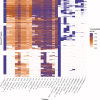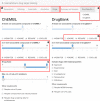Interactive online application for the prediction, ranking and prioritisation of drug targets in Schistosoma haematobium
- PMID: 30482220
- PMCID: PMC6257948
- DOI: 10.1186/s13071-018-3197-6
Interactive online application for the prediction, ranking and prioritisation of drug targets in Schistosoma haematobium
Abstract
Background: Human schistosomiasis is a neglected tropical disease caused by parasitic worms of the genus Schistosoma that still affects some 200 million people. The mainstay of schistosomiasis control is a single drug, praziquantel. The reliance on this drug carries a risk of resistance emerging to this anthelmintic, such that research towards alternative anti-schistosomal drugs is warranted. In this context, a number of studies have employed computational approaches to prioritise proteins for investigation as drug targets, based on extensive genomic, transcriptomic and small-molecule data now available.
Methods: Here, we established a customisable, online application for the prioritisation of drug targets and applied it, for the first time, to the entire inferred proteome of S. haematobium. This application enables selection of weighted and ranked proteins representing potential drug targets, and integrates transcriptional data, orthology and gene essentiality information as well as drug-drug target associations and chemical properties of predicted ligands.
Results: Using this application, we defined 25 potential drug targets in S. haematobium that associated with approved drugs, and 3402 targets that (although they could not be linked to any compounds) are conserved among a range of socioeconomically important flatworm species and might represent targets for new trematocides.
Conclusions: The online application developed here represents an interactive, customisable, expandable and reproducible drug target ranking and prioritisation approach that should be useful for the prediction of drug targets in schistosomes and other species of parasitic worms in the future. We have demonstrated the utility of this online application by predicting potential drug targets in S. haematobium that can now be evaluated using functional genomics tools and/or small molecules, to establish whether they are indeed essential for parasite survival, and to assist in the discovery of novel anti-schistosomal compounds.
Keywords: Computational drug discovery; Drug targets; Prioritisation systems; Schistosoma.
Conflict of interest statement
Ethics approval and consent to participate
Not applicable.
Consent for publication
Not applicable.
Competing interests
The authors declare that they have no competing interests.
Publisher’s Note
Springer Nature remains neutral with regard to jurisdictional claims in published maps and institutional affiliations.
Figures



Similar articles
-
Defining the Schistosoma haematobium kinome enables the prediction of essential kinases as anti-schistosome drug targets.Sci Rep. 2015 Dec 4;5:17759. doi: 10.1038/srep17759. Sci Rep. 2015. PMID: 26635209 Free PMC article.
-
Effect of praziquantel on the immature stages of Schistosoma haematobium.Int J Parasitol. 2005 Nov;35(13):1453-7. doi: 10.1016/j.ijpara.2005.05.002. Epub 2005 Jun 21. Int J Parasitol. 2005. PMID: 16002073
-
Evidence against rapid emergence of praziquantel resistance in Schistosoma haematobium, Kenya.Emerg Infect Dis. 2001 Nov-Dec;7(6):1069-70. doi: 10.3201/eid0706.010633. Emerg Infect Dis. 2001. PMID: 11747748 Free PMC article. No abstract available.
-
Therapeutic and operational profiles of metrifonate and praziquantel in Schistosoma haematobium infection.Arzneimittelforschung. 1999 Jul;49(7):557-65. doi: 10.1055/s-0031-1300462. Arzneimittelforschung. 1999. PMID: 10442201 Review.
-
New research tools for urogenital schistosomiasis.J Infect Dis. 2015 Mar 15;211(6):861-9. doi: 10.1093/infdis/jiu527. Epub 2014 Sep 19. J Infect Dis. 2015. PMID: 25240172 Free PMC article. Review.
References
-
- World Health Organization. Research priorities for helminth infections: technical report of the TDR disease reference group on helminth infections. WHO technical report series 972. 2012. http://apps.who.int/iris/bitstream/handle/10665/75922/WHO_TRS_972_eng.pdf. Accessed 5 Oct 2018. - PubMed
MeSH terms
Substances
LinkOut - more resources
Full Text Sources

